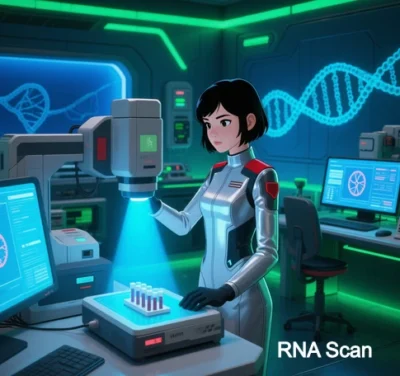
Synergistic Application of RNA Scan Technology with Clinical Diagnostics: Reshaping Modern Medicine
The integration of RNA Scan technology with other clinical diagnostic methods is revolutionizing medical diagnosis and treatment paradigms. This multi-dimensional synergy enhances detection accuracy and unlocks unique advantages in clinical decision support, dynamic monitoring, and personalized therapy. Below, we explore six core dimensions of its collaborative potential.
I. Multimodal Data Integration: Building Comprehensive Biomarker Maps
RNA Scan’s in situ spatial omics capabilities complement protein detection (e.g., CyTOF) and metabolomic analysis:
- Tumor Microenvironment Profiling: Combining RNAscope™ with Imaging Mass Cytometry (IMC) enables simultaneous detection of 12 RNA targets and 28 protein targets in a single sample, precisely mapping PD-L1 transcripts and CD8+ T-cell spatial distributions to reveal immune evasion mechanisms.
- Metabolic-Gene Regulatory Networks: Integrating LC-MS metabolomics data identifies lncRNA HOTAIR overexpression in hepatocellular carcinoma regions linked to activated glutamine metabolism, guiding targeted therapies.
II. Enhancing Diagnostic Sensitivity and Specificity
Combining RNA Scan with traditional methods overcomes single-technology limitations:
- Pathogen Differentiation: PrimeFlow RNA detection paired with Cas13 ribozymes achieves 1 copy/μL sensitivity for African swine fever virus while avoiding cross-reactivity with herpesviruses via CRISPR specificity.
- Fusion Gene Validation: RNAscope validates novel ALK fusions (initially detected by RNA-Capseq) in situ, circumventing false negatives from RNA degradation in NGS.
III. Dynamic Monitoring and Therapy Response Assessment
Integrating imaging and liquid biopsy enables end-to-end treatment management:
- Radiotherapy Sensitivity Prediction: In non-small cell lung cancer, pre-treatment miR-34a (a DNA repair miRNA) expression inversely correlates with PET-CT metabolic activity, predicting radiotherapy response two weeks earlier.
- Minimal Residual Disease Tracking: SCAN (ultrafast ligation-dependent RNA amplification) detects EGFR mutant RNA in blood seven days post-chemotherapy, offering a 10-day lead time over ctDNA for relapse warning.
IV. Precision Subtyping for Combination Therapies
Multi-omics cross-validation optimizes clinical pathways:
- Breast Cancer Subtyping: Adding RNA Scan-based quantification of ESR1 splice variants (e.g., ESR1-Y537S) to traditional IHC (ER/PR/HER2) increases endocrine therapy resistance detection by 38%.
- Immunotherapy Biomarkers: Combining ViewRNA-measured IFN-γ mRNA in tumor-infiltrating lymphocytes with PD-L1 CPS scores improves PD-1 inhibitor patient selection (AUC from 0.72 to 0.89).
V. Overcoming Technical Limitations Through Synergy
Cross-technology innovations address historical challenges:
- Degraded Sample Compatibility: PNA probes (cyclopentane-modified) boost RNA detection success in FFPE samples from 65% to 92%, even with RIN ≤1.
- Automation Integration: LabSat® microfluidics reduces RNAscope™ processing time from 18 hours to 6.5 hours, with <8% inter-batch CV for high-throughput clinical labs.
VI. Transforming Clinical Research Paradigms
Cross-platform data fusion enables novel research models:
- Single-Cell Multi-Omics: 10x Genomics scRNA-seq identifies biomarkers, validated by HCR™ RNA-FISH in thick tissue sections (≤1 cm) to map glioma stem cell niches.
- Gene Editing Efficacy Monitoring: PrimeFlow tracks CD137 mRNA in CRISPR-Cas9-edited CAR-T cells alongside serum cytokines for real-time dose optimization.
Case Studies in Synergistic Innovation
| Application Scenario | Technology Combination | Clinical Value | Data Enhancement |
|---|---|---|---|
| Post-Lung Cancer Monitoring | RNA Scan + ctDNA methylation analysis | Relapse detection sensitivity ↑72% → 89% | Time resolution (10-day lead time) |
| Autoimmune Diagnosis | ViewRNA + flow cytometry | Distinguishes active SLE vs. RA (94% specificity) | Cell subtype specificity |
| Antibiotic Stewardship | SCAN + microbial culture | Reduces unnecessary broad-spectrum use by 30% | Functional activity assessment |
| Cancer Vaccine Development | RNAscope + TCR sequencing | Maps neoantigen-T cell spatial correlations | Spatial immune microenvironment |
Challenges and Future Directions
Despite its advantages, key hurdles remain:
- Standardization: Unified quantification standards (e.g., converting RNAscope dot counts to FPKM-like units) are needed for cross-platform data integration.
- Computational Biology: Develop cross-modal deep learning models (e.g., graph neural networks) to integrate RNA spatial data with CT imaging for treatment prediction.
- Miniaturized Integration: Combine microfluidics with nanopore sequencing for fully automated “tissue-in, report-out” diagnostics.
The synergy of RNA Scan with other technologies expands diagnostic dimensions and redefines the biological boundaries of clinical decision-making. This convergence is driving medicine from the “single biomarker era” toward a “multi-dimensional systems medicine” paradigm. Future breakthroughs will hinge on deep integration across bioengineering, computational science, and clinical practice.
Data sourced from public references. Contact: chuanchuan810@gmail.com.




